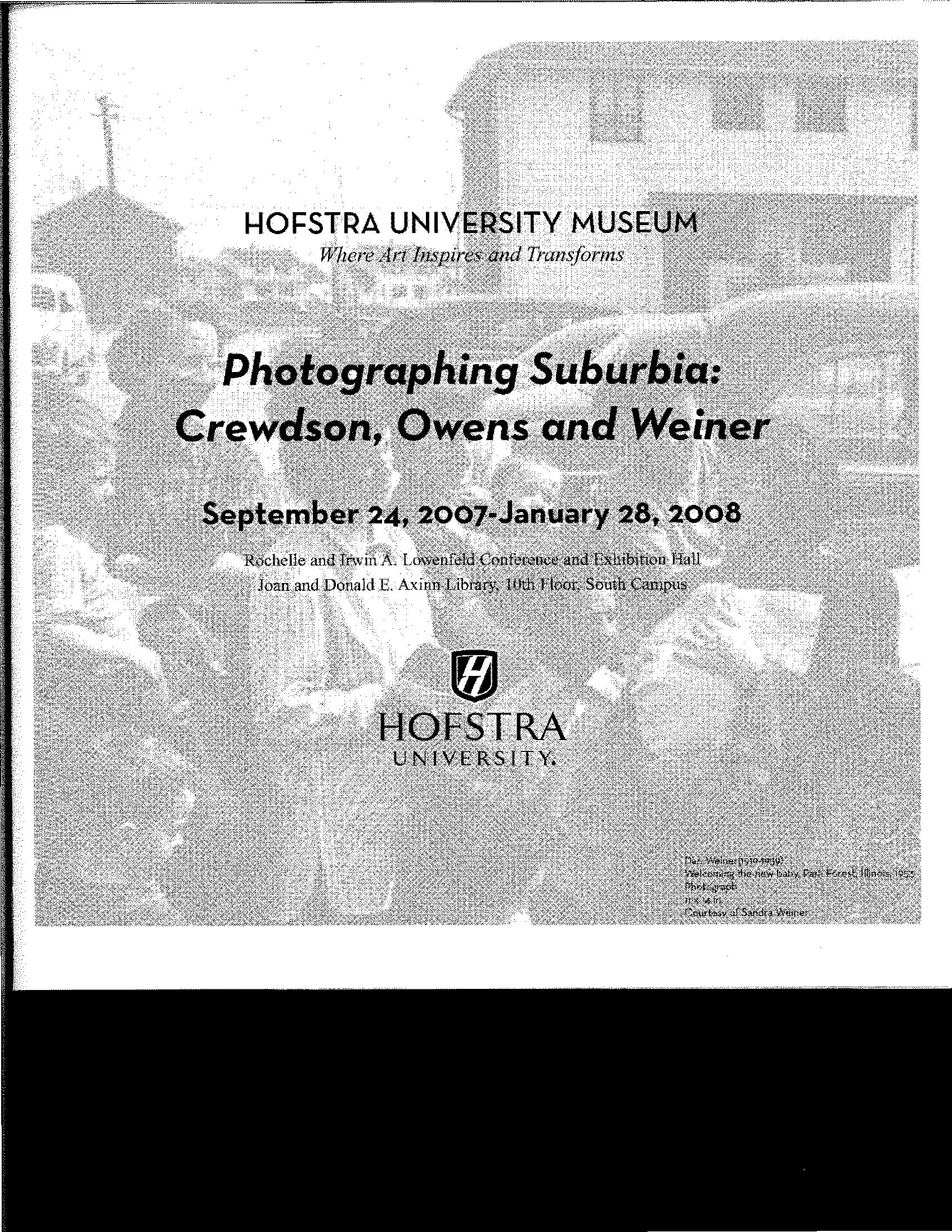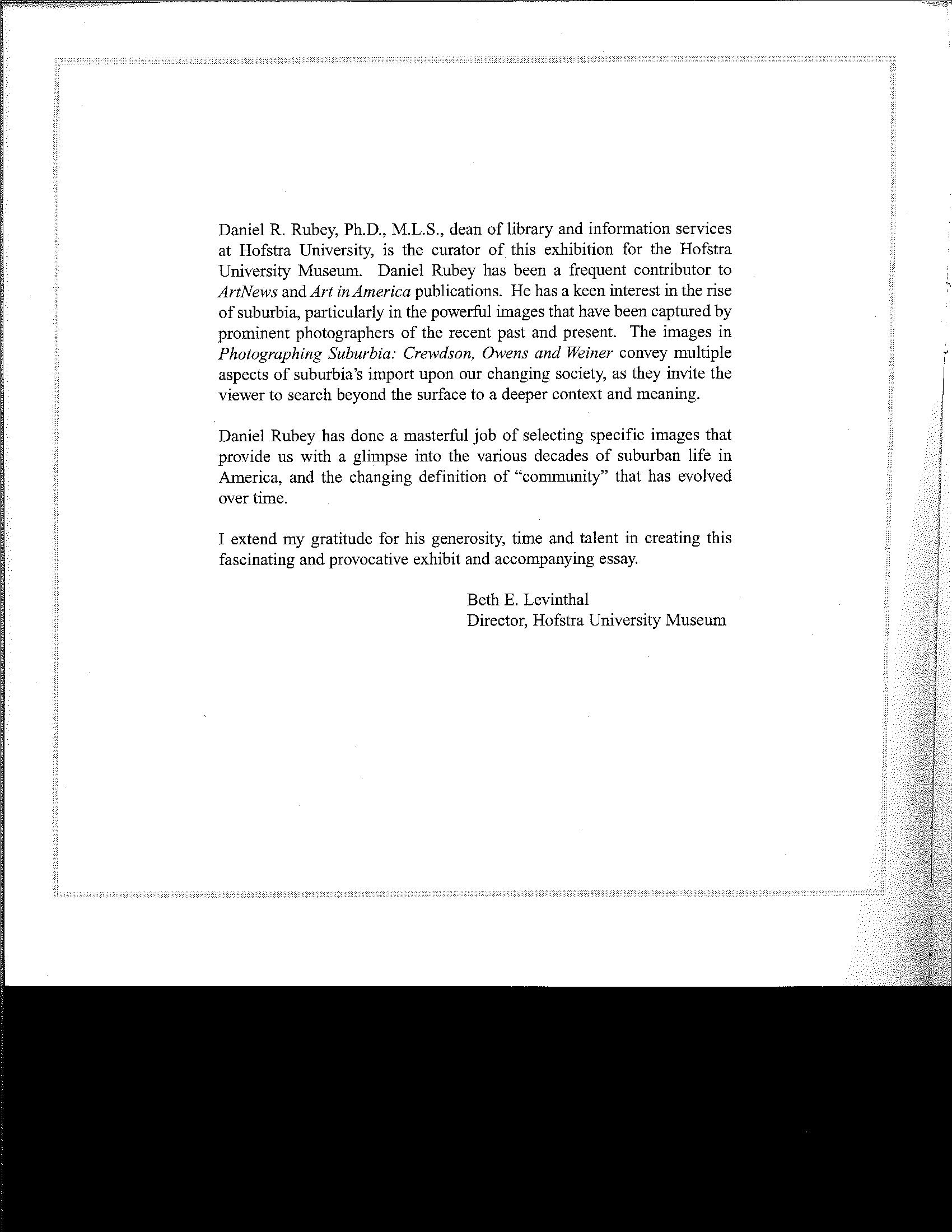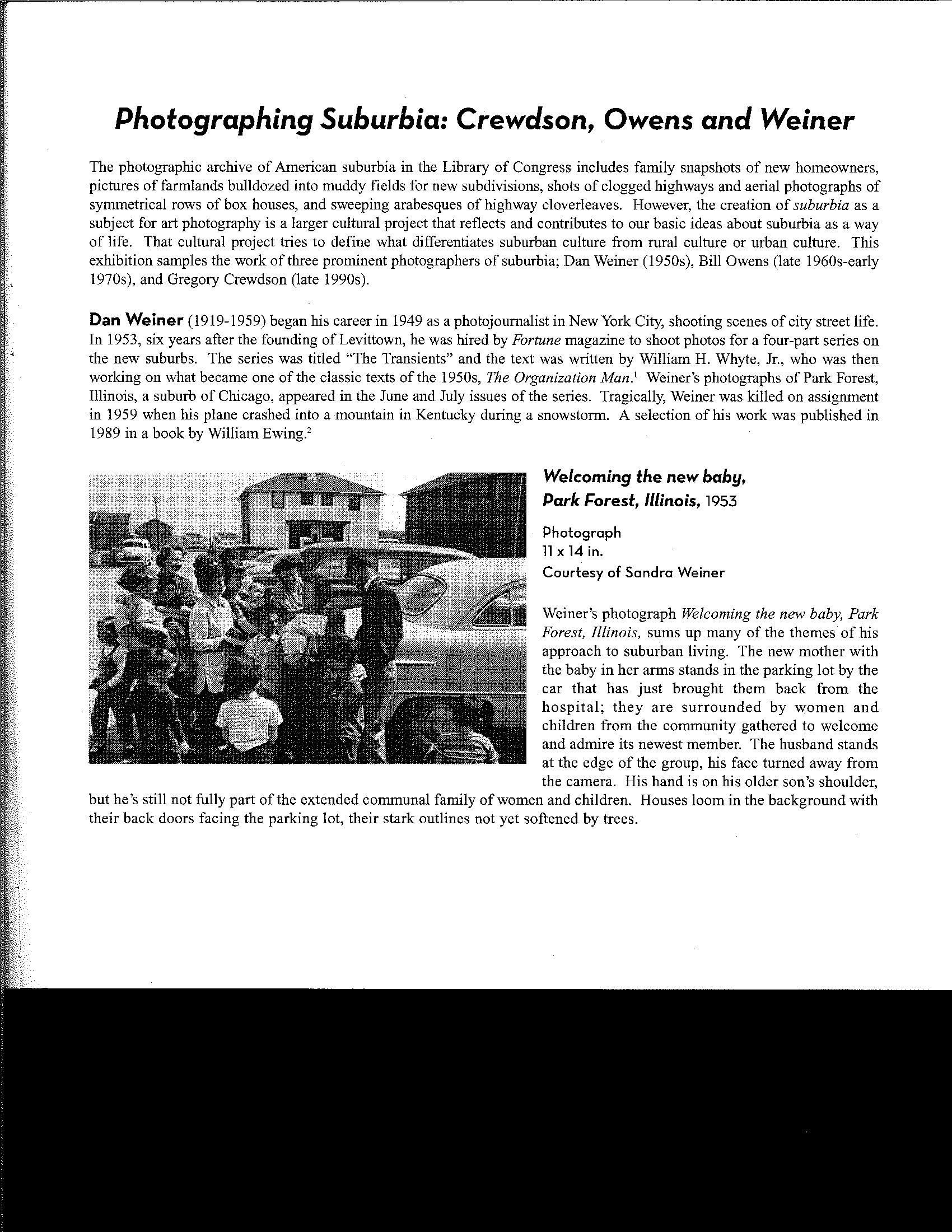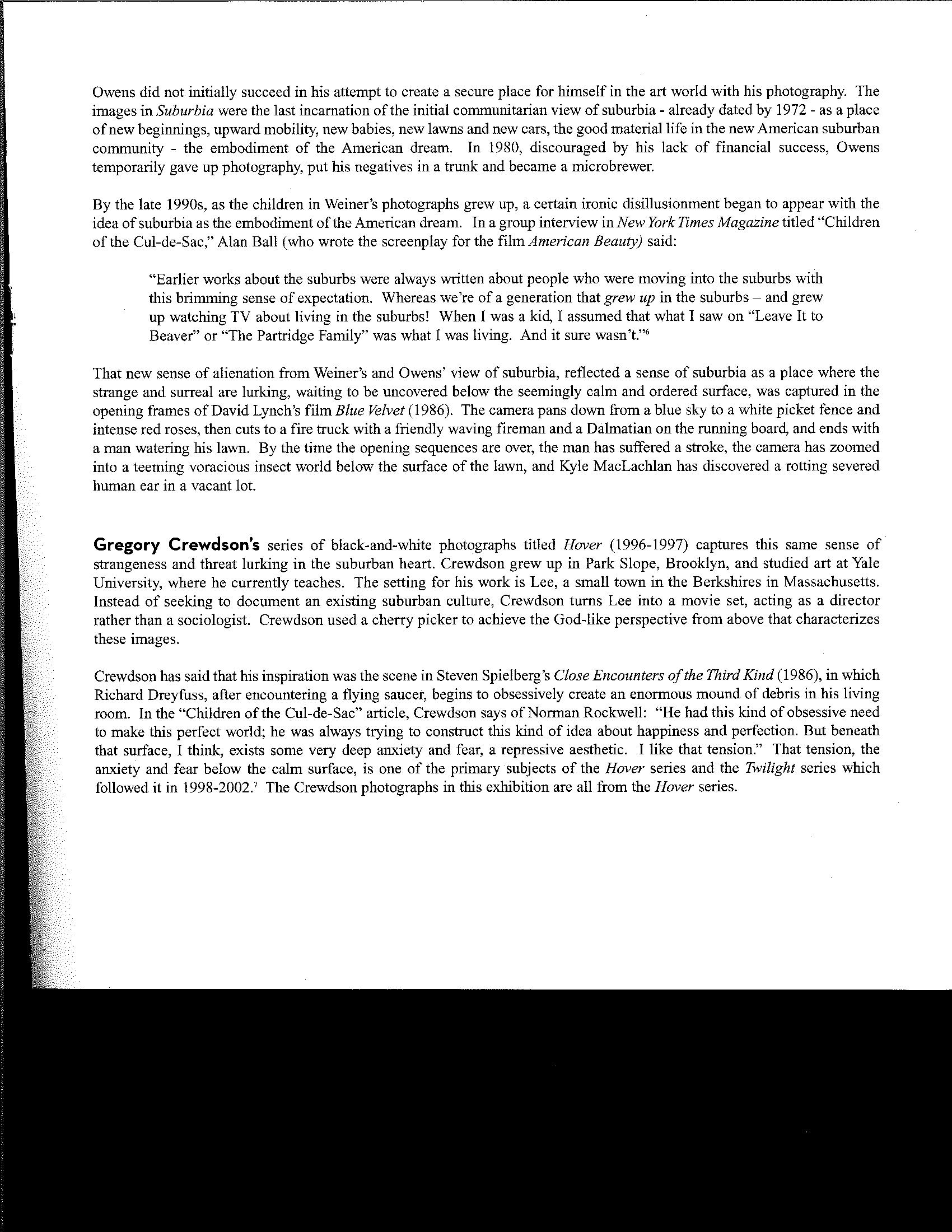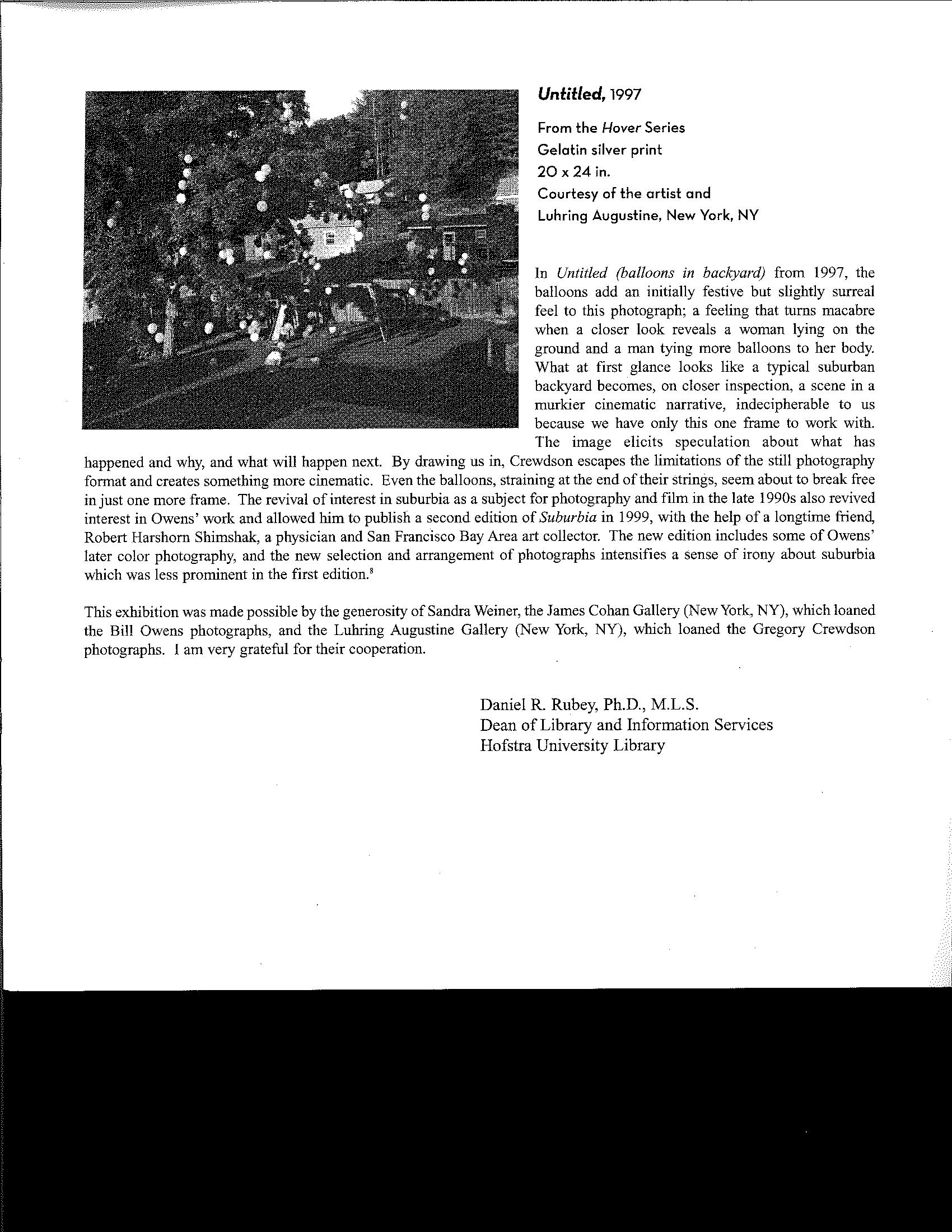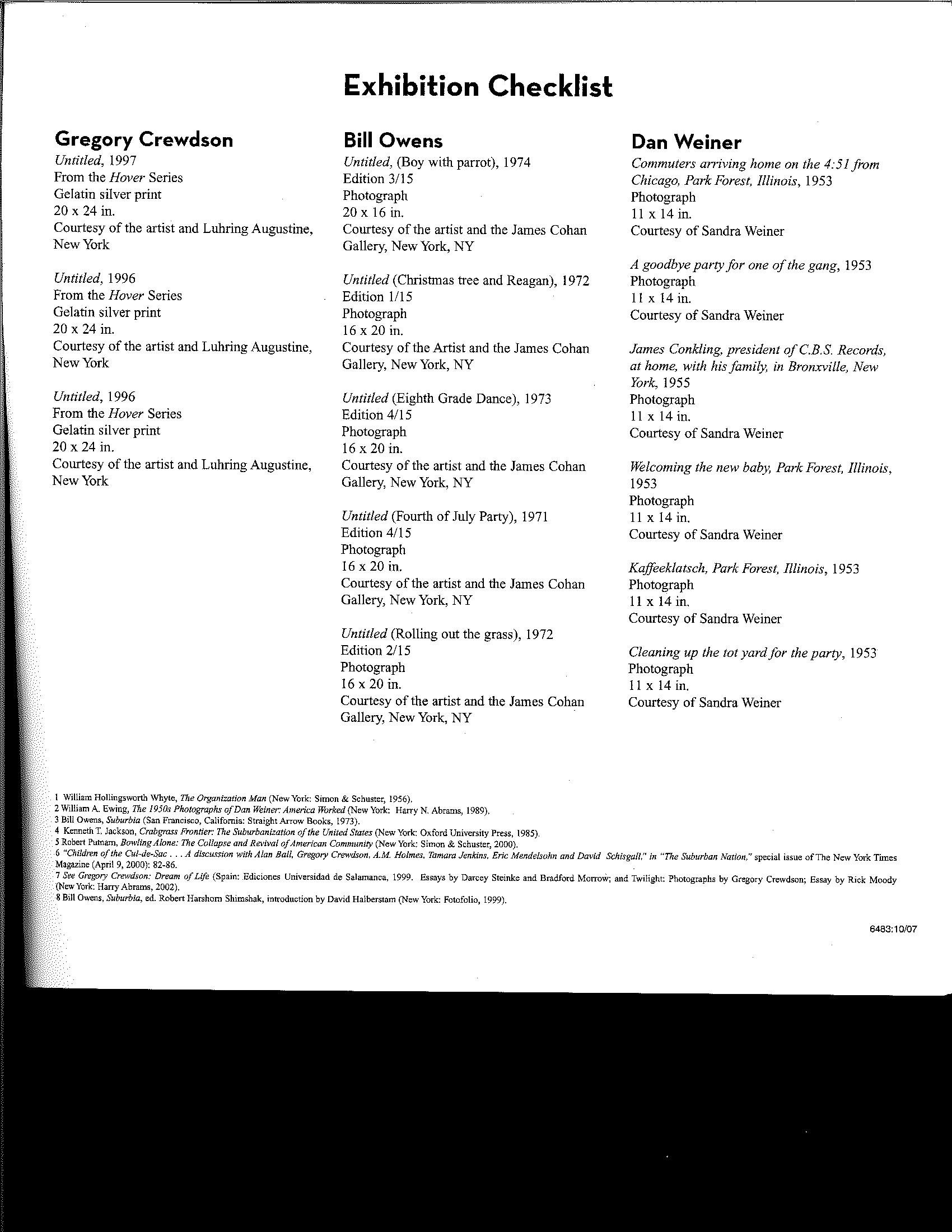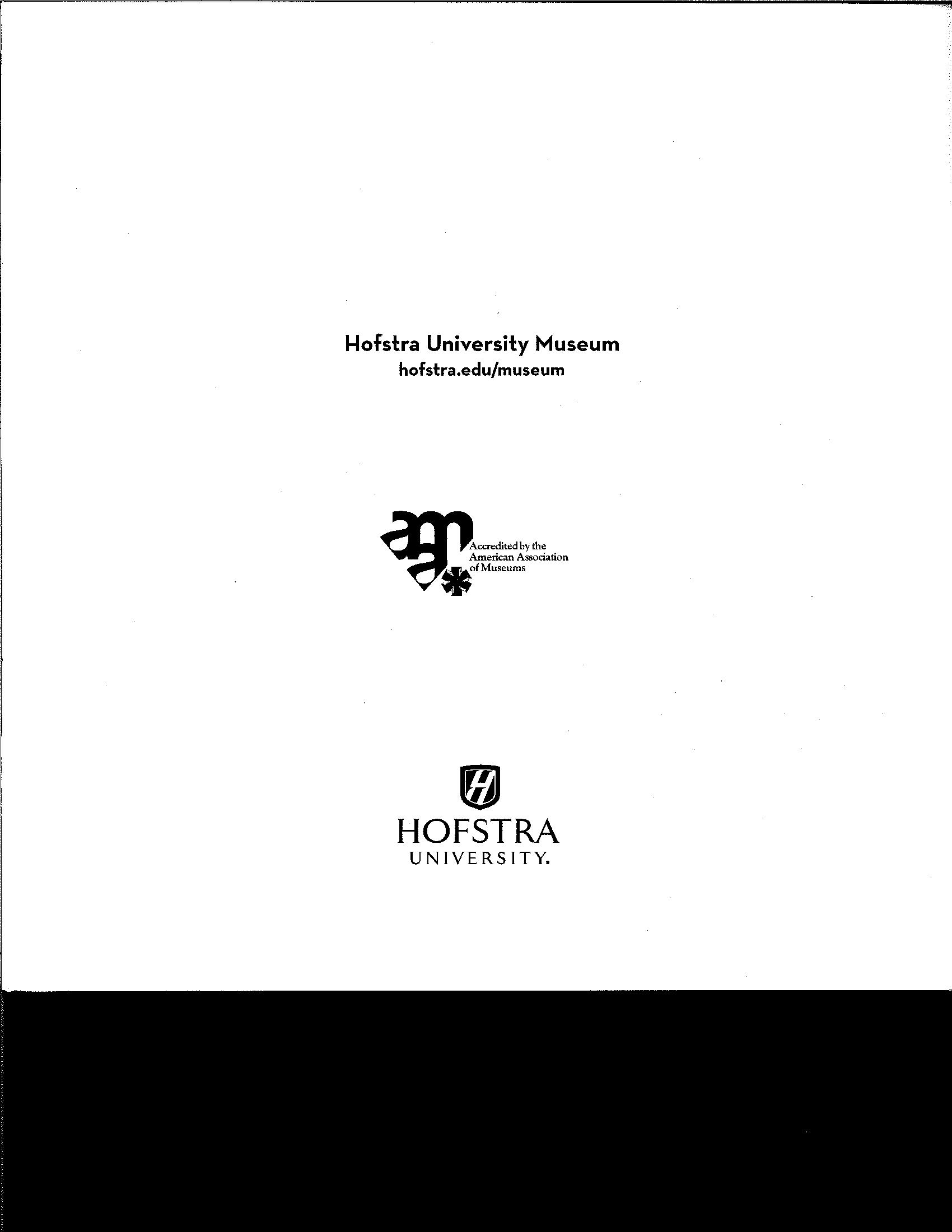Photographing Suburbia: Crewdson, Owens and Weiner
The photographic archive of American suburbia in the Library of Congress includes family snapshots of new homeowners, pictures of farmlands bulldozed into muddy fields for new subdivisions, shots of clogged highways and aerial photographs of symmetrical rows of box houses, and sweeping arabesques of highway cloverleaves. However, the creation of suburbia as a subject for art photography is a larger cultural project that reflects and contributes to our basic ideas about suburbia as a way of life. That cultural project tries to define what differentiates suburban culture from rural culture or urban culture. This exhibition samples the work of three prominent photographers of suburbia; Dan Weiner (1950s), Bill Owens (late 1960s-early 1970s), and Gregory Crewdson (late 1990s).
Dan Weiner (1919-1959) began his career in 1949 as a photojournalist in New York City, shooting scenes of city street life. In 1953, six years after the founding ofLevittown, he was hired by Fortune magazine to shoot photos for a four-part series on the new suburbs. The series was titled "The Transients" and the text was written by William H. Whyte, Jr., who was then working on what became one of the classic texts of the 1950s, The Organization Man. 1 Weiner's photographs of Park Forest, Illinois, a suburb of Chicago, appeared in the June and July issues of the series. Tragically, Weiner was killed on assigmnent in 1959 when his plane crashed into a mountain in Kentucky during a snowstorm. A selection of his work was published in 1989 in a book by William Ewing.'
Welc:oming the new baby, Park i=orest, Illinois, 7953
Photograph llxl4in.
Courtesy of Sandra Weiner
Weiner's photograph Welcoming the new baby, Park Forest, Illinois, sums up many of the themes of his approach to suburban living. The new mother with the baby in her arms stands in the parking lot by the car that has just brought them back from the hospital; they are surrounded by women and children from the community gathered to welcome and admire its newest member. The husband stands at the edge of the group, his face turned away from the camera. His hand is on his older son's shoulder, but he's still not fully part of the extended communal family of women and children. Houses loom in the background with their back doors facing the parking lot, their stark outlines not yet softened by trees.
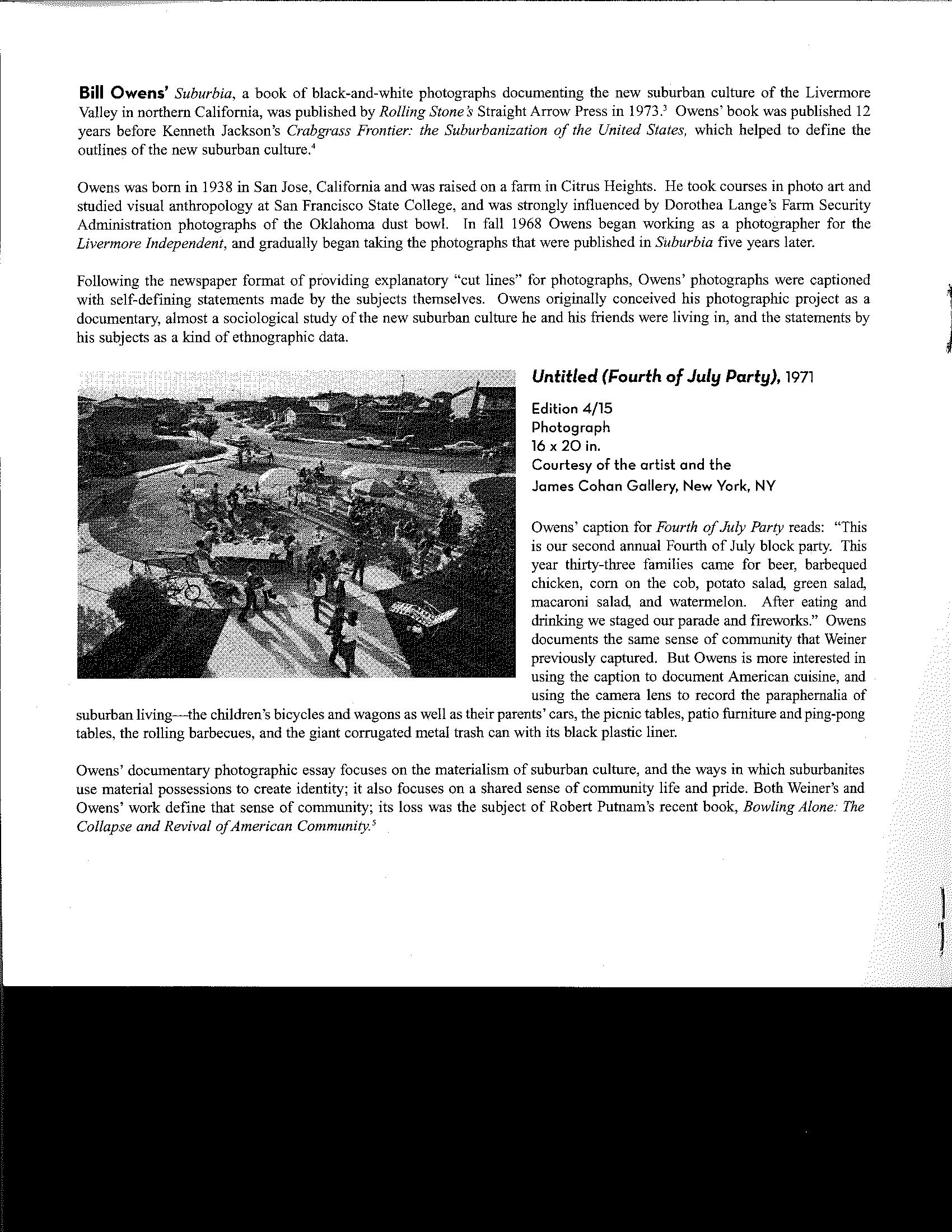
Bill Owens' Suburbia, a book of black-and-white photographs documenting the new suburban culture of the Livermore Valley in northern California, was published by Rolling Stones Straight Arrow Press in 1973.3 Owens' book was published 12 years before Kenneth Jackson's Crabgrass Frontier: the Suburbanization of the United States, which helped to define the outlines of the new suburban culture.4
Owens was born in 1938 in San Jose, California and was raised on a farm in Citrus Heights. He took courses in photo art and studied visual anthropology at San Francisco State College, and was strongly influenced by Dorothea Lange's Farm Security Administration photographs of the Oklahoma dust bowl. In fall 1968 Owens began working as a photographer for the Livermore Independent, and gradually began taking the photographs that were published in Suburbia five years later.
Following the newspaper format of providing explanatory "cut lines" for photographs, Owens' photographs were captioned with self-defining statements made by the subjects themselves. Owens originally conceived his photographic project as a documentary, almost a sociological study of the new suburban culture he and his friends were living in, and the statements by his subjects as a kind of ethnographic data.
Untitled (Fourth of July Party), 1971
Edition 4/15
Photograph 16 X 20 in.
Courtesy of the artist and the James Cohan Gallery, New York, NY
Owens' caption for Fourth of July Party reads: "This is our second annual Fourth of July block party. This year thirty-three families came for beer, barbequed chicken, com on the cob, potato salad, green salad, macaroni salad, and watermelon. After eating and drinking we staged our parade and fireworks." Owens documents the same sense of community that Weiner previously captured. But Owens is more interested in using the caption to document American cuisine, and using the camera lens to record the paraphernaliaof
suburban living-the children's bicycles and wagons as well as their parents' cars, the picnic tables, patio furniture and ping-pong tables, the rolling barbecues, and the giant corrugated metal trash can with its black plastic liner.
Owens' documentary photographic essay focuses on the materialism of suburban culture, and the ways in which suburbanites use material possessions to create identity; it also focuses on a shared sense of community life and pride. Both Weiner's and Owens' work define that sense of community; its loss was the subject of Robert Putnam's recent book, Bowling Alone: The Collapse and Revival of American Community.5
Owens did not initially succeed in his attempt to create a secure place for himself in the art world with his photography. The images in Suburbia were the last incarnation of the initial communitarian view of suburbia -already dated by 1972 -as a place of new beginnings, upward mobility, new babies, new lawns and new cars, the good material life in the new American suburban community -the embodiment of the American dream. In 1980, discouraged by his lack of financial success, Owens temporarily gave up photography, put his negatives in a trnnk and became a microbrewer.
By the late l 990s, as the children in Weiner's photographs grew up, a certain ironic disillusionment began to appear with the idea of suburbia as the embodiment of the American dream. In a group interview in New York Times Magazine titled "Children of the Cul-de-Sac," Alan Ball (who wrote the screenplay for the film American Beauty) said:
"Earlier works about the suburbs were always written about people who were moving into the suburbs with this brimming sense of expectation. Whereas we're of a generation that grew up in the suburbs -and grew up watching TV about living in the suburbs! When I was a kid, I assumed that what I saw on "Leave It to Beaver" or "The Partridge Family" was what I was living. And it sure wasn't."'
That new sense of alienation from Weiner's and Owens' view of suburbia, reflected a sense of suburbia as a place where the strange and surreal are lurking, waiting to be uncovered below the seemingly calm and ordered surface, was captured in the opening frames of David Lynch's film Blue Velvet (1986). The camera pans down from a blue sky to a white picket fence and intense red roses, then cuts to a fire truck with a friendly waving fireman and a Dalmatian on the running board, and ends with a man watering his lawn. By the time the opening sequences are over, the man has suffered a stroke, the camera has zoomed into a teeming voracious insect world below the surface of the lawn, and Kyle MacLachlan has discovered a rotting severed human ear in a vacant lot.
Gregory Crewdson's series of black-and-white photographs titled Hover (1996-1997) captures this same sense of strangeness and threat lurking in the suburban heart. Crewdson grew up in Park Slope, Brooklyn, and studied art at Yale University, where he currently teaches. The setting for his work is Lee, a small town in the Berkshires in Massachusetts. Instead of seeking to document an existing suburban culture, Crewdson turns Lee into a movie set, acting as a director rather than a sociologist. Crewdson used a cherry picker to achieve the God-like perspective from above that characterizes these images.
Crewdson has said that his inspiration was the scene in Steven Spielberg's Close Encounters of the Third Kind (1986), in which Richard Dreyfuss, after encountering a flying saucer, begins to obsessively create an enormous mound of debris in his living room. In the "Children of the Cul-de-Sac" article, Crewdson says of Norman Rockwell: "He had this kind of obsessive need to make this perfect world; he was always trying to construct this kind of idea about happiness and perfection. But beneath that surface, I think, exists some very deep anxiety and fear, a repressive aesthetic. I like that tension." That tension, the anxiety and fear below the calm surface, is one of the primary subjects of the Hover series and the Twilight series which followed it in 1998-2002.' The Crewdson photographs in this exhibition are all from the Hover series.
Untitled, 1997
l=rom the /-lover Series
Gelatin silver print
20 X 24 in.
Courtesy of the artist and Luhring Augustine, New York, NY
In Untitled (balloons in backyard) from 1997, the balloons add an initially festive but slightly surreal feel to this photograph; a feeling that turns macabre when a closer look reveals a woman lying on the ground and a man tying more balloons to her body. What at first glance looks like a typical suburban backyard becomes, on closer inspection, a scene in a murkier cinematic narrative, indecipherable to us because we have only this one frame to work with. The image elicits speculation about what has happened and why, and what will happen next. By drawing us in, Crewdson escapes the limitations of the still photography format and creates something more cinematic. Even the balloons, straining at the end of their strings, seem about to break free in just one more frame. The revival of interest in suburbia as a subject for photography and film in the late 1990s also revived interest in Owens' work and allowed him to publish a second edition of Suburbia in 1999, with the help ofa longtime friend, Robert Harshom Shimshak, a physician and San Francisco Bay Area art collector. The new edition includes some of Owens' later color photography, and the new selection and arrangementof photographs intensifies a sense of irony about suburbia which was less prominent in the first edition.8
This exhibition was made possible by the generosity of Sandra Weiner,the James Cohan Gallery (New York, NY), which loaned the Bil! Owens photographs, and the Luhring Augustine Gallery (New York, NY), which loaned the Gregory Crewdson photographs. I am very grateful for their cooperation.
Daniel R. Rubey, Ph.D., M.L.S.
Dean of Library and Information Services
Hofstra University Library
Gregory Crewdson
Untitled, 1997
From the Hover Series
Gelatin silver print
20 X 24 in.
Courtesy of the artist and Luhring Augustine, New York
Untitled, 1996
From the Hover Series
Gelatin silver print
20 X 24 in.
Courtesy of the artist and Luhring Augustine, New York
Untitled, 1996
From the Hover Series
Gelatin silver print
20 X 24 in.
Courtesy of the artist and Luhring Augustine, New York
Exhibition Checklist
Bill Owens
Untitled, (Boy with parrot), 1974 Edition 3/15
Photograph 20xl6in.
Courtesy of the artist and the James Cohan Gallery, New York, NY
Untitled (Christmas tree and Reagan), 1972 Edition 1/15
Photograph 16x20in.
Courtesy of the Artist and the James Cohan Gallery, New York, NY
Untitled (Eighth Grade Dance), 1973 Edition 4/15
Photograph 16x20in.
Courtesy of the artist and the James Cohan Gallery, New York, NY
Untitled (Fourth of July Party), 1971 Edition 4/15
Photograph 16x20in.
Courtesy of the artist and the James Cohan Gallery, New York, NY
Untitled (Rolling out the grass), 1972 Edition 2/15
Photograph 16x20in.
Courtesy of the artist and the James Cohan Gallery, New York, NY
Dan Weiner
Commuters alTiving home on the 4:51 from Chicago, Park Forest, Illinois, 1953
Photograph llxl4in.
Courtesy of Sandra Weiner
A goodbye party for one of the gang, 1953
Photograph 11 X J4in.
Courtesy of Sandra Weiner
James Conkling, president ofC.B.S. Records, at home, with his family, in Bronxville, New York, 1955
Photograph 11 X 14in.
Courtesy of Sandra Weiner
Welcoming the new baby, Park Forest, Illinois, 1953
Photograph 11 X 14 in.
Courtesy of Sandra Weiner
Kaffeeklatsch, Park Forest, Illinois, 1953
Photograph llxl4in.
Courtesy of Sandra Weiner
Cleaning up the tot yard for the party, 1953
Photograph llxl4in.
Courtesy of Sandra Weiner
I William Hollingsworth Whyte, The Organization Man (New York: Simon & Schuster, 1956).
2 Wil!iamA. Ewing, The 1950.i Photographs of Dan Weiner:America Worked (New York: Harry N. Abrams, 1989).
3 Bil! Owens, Suburbia (San Francisco, California: Straight Arrow Books, 1973).
4 KennethT. Jackson, Crabgrass Frontier: The Suburbanization of the United States (New York: Oxford University Press, 1985)
5 Robert Putnam, Bowling Alone: The Collapse and Revival of AmericWI Community (New York: Simon & Schuster, 2000).
6 "Children of the Cul-de-Sac A discussion with Alan Ball, Gregory Crewdson, A.M. Holmes. Tamara Jenkins. Eric Mendelsohn and David Schisgal/," in ''The Suburban Nation,"' special issue of The New York Times Magazine (April 9, 2000): 82-86.
7 See Gregory Crewdo·on:Dream of Life (Spain: Ediciones Universidad de Salamanca, 1999. Essays by Darcey Steinke and Bradford Mon-oW; and Twilight: Photographs by Gregory Crewdson; Essay by Rick Moody (NewYork:Harry Abrams, 2002).
8 Bill Owens, Suburbia, ed. Robert Harshorn Shimshak, introduction by David Halberstam (New York: Fotofolio, 1999).
l-lofst:ra University Museum
hofstra.edu/museum
